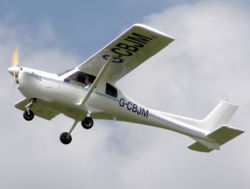PlaneSpottingWorld welcomes all new members! Please gives your ideas at the Terminal.
Jabiru Aircraft
| Jabiru Aircraft Company Pty Ltd | |
| Type | PTY Ltd. |
|---|---|
| Founded | 1988 |
| Headquarters | Bundaberg, Australia |
| Key people | Rodney Stiff Phil Ainsworth |
| Industry | Light aircraft Manufacturers |
| Products | Light aircraft and aircraft engines |
| Website | http://www.jabiru.net.au |
This article is about the aircraft. For the stork see Jabiru.
The Jabiru Aircraft Company Pty Ltd produces a range of small civil utility aircraft designed and manufactured in Bundaberg, Australia. They also design and manufacture a range of engines, specifically designed for light aircraft use. The aircraft are available as kit and ready-built versions. Types include microlight (Ultralight or ULM), commonly called the Calypso, 2 seater trainer (J160/ J170) and four seat aircraft (J400/ J430).
The aircraft are built largely of composite materials and are conventional high-wing monoplanes with typically tricycle undercarriage, although taildragger versions are also available. The wings can be removed for ease of storage or transportation.
Use of modern composite techniques has resulted in a strong yet light structure. The aircraft are designed around the pilot and passengers, being spacious and comfortable for touring, yet with a small footprint and frontal profile. Controls include a centrally mounted control column, brake and trim lever.
Brief History
The company was formed in 1988 by Rodney Stiff and Phil Ainsworth to manufacture affordable light aircraft in kit and certified forms. In October 1991, the first aircraft (Jabiru LSA 55/2k), was certified by the Australian Civil Aviation Authority.
Due to the original engine manufacturer ceasing production of aero engines, the company started development of their own engines, and by 1995 the Jabiru 2200, a flat 4 aircooled aviation engine, was available for delivery. Since then the 6 cylinder Jabiru 3300 and 8 cylinder Jabiru 5100 engines have been added to the range. In the same year, 1995, it was decided to offer these aircraft as amateur build or experimental self build kits.
Achievements
The microlight version of the Jabiru 2 seater aircraft, the Jabiru UL, holds 2 world speed records, [1] for 3 axis microlight aircraft. These were set over 50 and 100km predefined courses and certified by the FAI, (Fédération Aéronautique Internationale).
Aircraft
Factory-built
- LSA - configured to meet ultralight regulations
- ST3 - configured to meet general aviation regulations
- UL-D - configured to meet UK Microlight regulations
- J160C - Certified with 2200 Engine
- J230C - Certified with 3300 Engine
Kitplanes
- J200 - 2-seat aircraft
- J400 - 4-seat aircraft
- SP - Light aircraft version
- SP-T - Taildragger version of SP
- UL - export version to meet European microlight regulations (Calypso)
- UL-T - taildragger version of UL
Specifications (Jabiru J200)
Template:Aircraft specification
Specifications (Calypso)
Calypso Microlight (ULM) aircraft
- Crew: 1
- Capacity: 1 pilot + 1 passenger
- Length: 5.64 m (18 ft 6 in)
- Wingspan: 9.4 m (30 ft 10 in)
- Height: 2.01 m (6 ft 7in)
- Wing area: 9.31 m² (100 ft²)
- Empty: 265 kg (583 lb)
- Maximum take off weight: 450 kg (990 lb)
- Powerplant: 1x Jabiru 2200, 85 hp
- Cruise speed: 95 - 100kt
- Maximum speed: 116kt
- Fuel consumption: 14 litres per hour, at 75% cruise.
Engines
Jabiru produce their own range of lightweight 4-stroke horizontally opposed aircooled engines, specifically designed and engineered for use in aircraft. All engines are direct drive and are fitted with alternators, silencers, vacuum pump drives and dual ignition systems as standard. Over 2000 4-cylinder engines and over 750 of the 6-cylinder engines have been produced. The basic design is now so mature that only minor design changes have been made in the last 1000 engines or so.
Available Engines
- Jabiru 2200; 4-cylinder at 85 bhp (64 kW)
- Jabiru 3300; 6-cylinder at 120 bhp (89 kW)
- Jabiru 5100; 8-cylinder at 180 bhp (134 kW)
External links
Related content
Related development:
Comparable aircraft: 3Xtrim 3X55 Trener
Designation sequence:
Lists relating to aviation | |
|---|---|
| General | Timeline of aviation · Aircraft · Aircraft manufacturers · Aircraft engines · Aircraft engine manufacturers · Airports · Airlines |
| Military | Air forces · Aircraft weapons · Missiles · Unmanned aerial vehicles (UAVs) · Experimental aircraft |
| Notable incidents and accidents | Military aviation · Airliners · General aviation · Famous aviation-related deaths |
| Records | Flight airspeed record · Flight distance record · Flight altitude record · Flight endurance record · Most produced aircraft |


